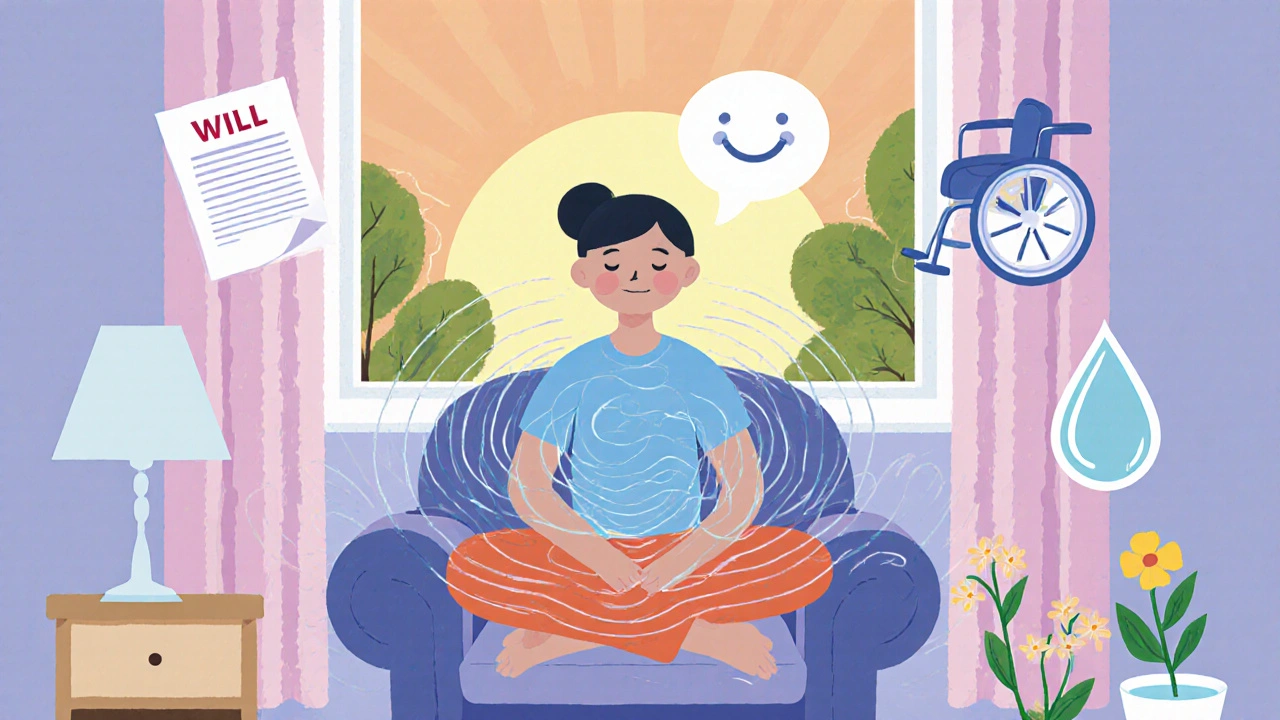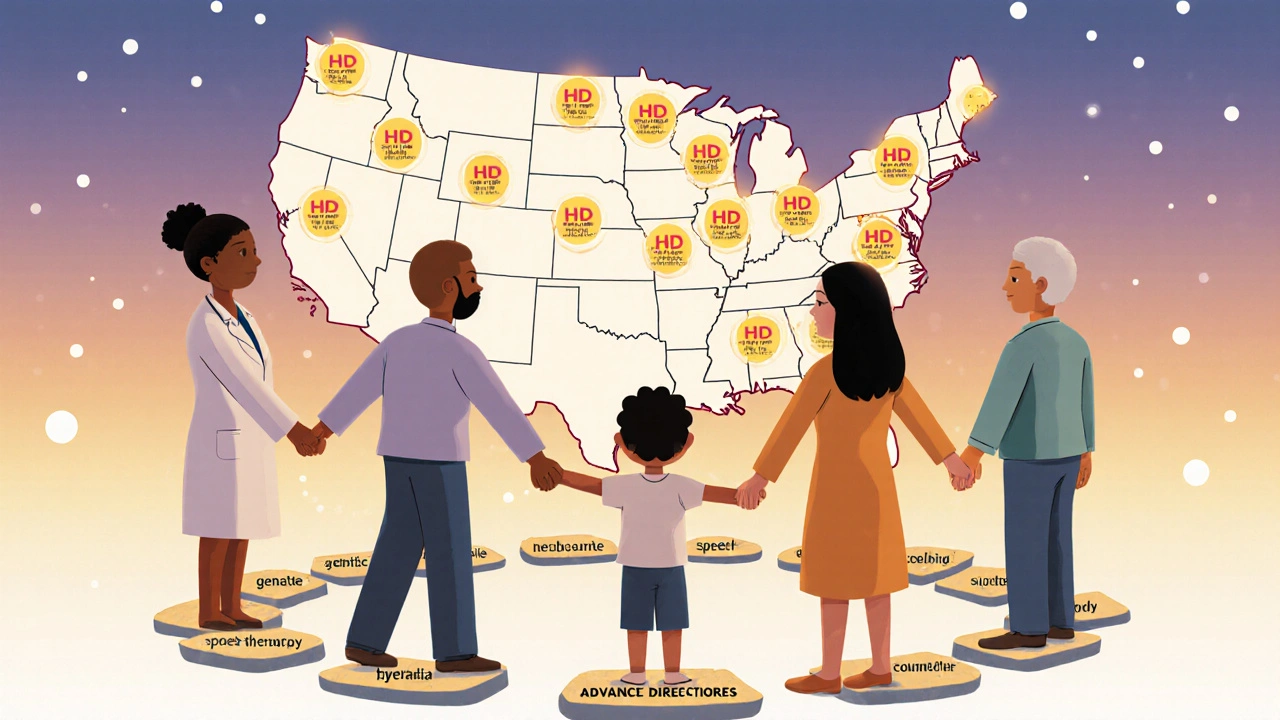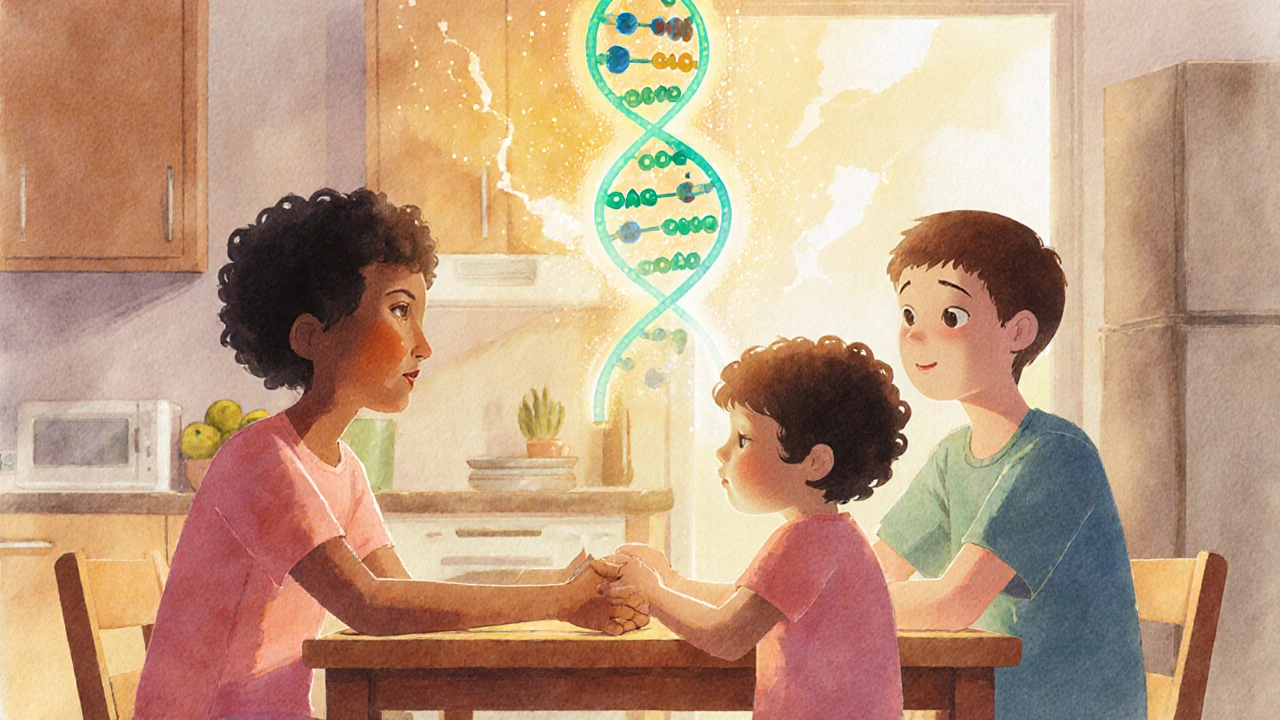When someone is diagnosed with Huntington’s disease, the moment doesn’t just change their life-it reshapes the entire family’s future. There’s no cure. No magic pill. Just a slow, predictable decline that starts with a twitch, a stumble, or a mood swing no one can explain. And yet, even with no cure, there’s power in knowing what’s coming-and planning for it. This isn’t about hope in the sense of a miracle drug. It’s about hope in the sense of control: control over your choices, your care, and your dignity as the disease moves through your body.
The Genetics Behind Huntington’s Disease
Huntington’s disease isn’t something you catch. It’s something you inherit. Every child of a parent with HD has a 50% chance of getting the faulty gene. That’s not a guess. It’s biology. The gene responsible, called HTT, sits on chromosome 4. Inside it, a tiny section of DNA-CAG-repeats too many times. Normal people have 10 to 26 repeats. People with HD have 40 or more. If you have 36 to 39, you might never show symptoms, or you might later in life. But if you hit 40? You will develop the disease. What makes this even harder is how it passes down. When the gene comes from the father, it often gets worse. That’s called genetic anticipation. A father with 45 repeats might pass on 52 to his child. That child could show symptoms in their teens instead of their 40s. That’s why nearly 90% of juvenile Huntington’s cases come from the father’s side. And if you’re the child of someone with HD, you’re not just watching your parent decline-you’re also watching your own future unfold. There’s no test you can take at 18 and say, “Okay, I’m safe.” The test only tells you if you have the gene. It doesn’t tell you when symptoms will start, how fast they’ll come, or how bad they’ll get. That’s why so many at-risk people delay testing. One Reddit user wrote: “I don’t want to know. Not yet. I want to keep pretending I’m normal.” But waiting doesn’t stop the clock. It just makes planning harder.Chorea: When Your Body Moves Without You
Chorea is the name for those sudden, jerky, unpredictable movements that make HD so visible. They look like fidgeting, dancing, or twitching-but they’re not under your control. Your arm might fling out while you’re trying to hold a cup. Your foot might kick sideways while you’re sitting still. These movements get worse when you’re stressed, tired, or trying to focus. They vanish when you sleep. That’s why people often don’t notice them at first. They think it’s just nerves. Doctors measure chorea using something called the Unified Huntington’s Disease Rating Scale, or UHDRS. A score of 1 means mild, barely noticeable movements. A score of 4 means constant, wild motion that makes holding a spoon impossible. In early HD, chorea shows up in fingers and hands. Later, it spreads to the face, neck, and legs. By the time someone needs a wheelchair, chorea often fades-not because it’s gone, but because muscles are too weak to move at all. That’s when dystonia, stiffness, and slow movements take over. The only FDA-approved drugs for chorea are tetrabenazine and deutetrabenazine (Austedo). Tetrabenazine cuts chorea by about 25-30%. But it comes with a cost: 1 in 5 people get depressed. Some even have suicidal thoughts. That’s why doctors don’t always prescribe it right away. If the movements aren’t causing falls or making it impossible to eat, sometimes it’s better to wait. Valbenazine (Ingrezza), approved in 2023, works similarly but may have fewer mood side effects. Still, none of these drugs stop the disease. They just make the symptoms a little less loud.
Care Planning: The Real Lifesaver
You can’t stop Huntington’s disease. But you can change how it ends. The most important thing you can do isn’t a drug. It’s a conversation. Early on, when you’re still working, driving, and cooking meals, you need to talk to your family about what happens next. By the time symptoms appear, 78% of people who get care through specialized HD centers have already written a living will and named a healthcare proxy. That’s not because they’re giving up. It’s because they’re taking back control. Who will decide if you can’t swallow? Who will say no to a feeding tube if you’ve said you don’t want one? Who will make sure your wishes are followed when you can’t speak? Care planning isn’t a one-time event. It’s a series of steps:- Early stage (0-5 years after diagnosis): Talk to a genetic counselor. Update your will. Talk to your employer about accommodations. Start seeing a neurologist who knows HD-not just any neurologist. Get a physical therapist to help you stay strong.
- Mid-stage (5-15 years): You’ll likely need help dressing, bathing, and eating. Occupational therapy becomes essential. Speech therapy helps with slurred speech and swallowing problems. By year 10, nearly half of patients need speech therapy. Around 65% need help with daily tasks.
- Late stage (15+ years): Most people can’t live at home anymore. 89% end up in a care facility by 20 years. That’s not failure. It’s safety. At this point, the biggest risks are choking, pneumonia, and falls. A care team that knows HD can reduce hospital stays by a third.
The Hidden Costs of Care
Huntington’s disease doesn’t just take your body. It takes your money. The average annual cost of care in the U.S. is $125,000. That’s for nursing home care, medications, therapy, home modifications, and lost income. Most insurance doesn’t cover everything. Out-of-pocket costs can hit $5,000 a year for things like aquatic therapy, specialized equipment, or home aides. Aquatic therapy is one of the most effective tools for HD. Water supports weak muscles, reduces fall risk, and improves balance better than land-based exercises. But not all insurance pays for it. Many families choose between paying for therapy or paying the mortgage. Care coordination is another hidden burden. One caregiver on the HDSA forum said she spends 20 hours a week just scheduling appointments-neurologist, psychiatrist, PT, OT, nutritionist, social worker. No one person can manage all that. That’s why specialized HD centers have care coordinators. They’re the glue. But only 38% of U.S. neurologists follow the official care guidelines. Most patients are left to figure it out alone.
What Works-And What Doesn’t
There’s a lot of noise out there. Supplements. Diets. Stem cells. Experimental gene therapies. The truth? Nothing has been proven to stop HD yet. But some things have been proven to help you live better.- Physical therapy: Keeps you mobile longer. Reduces falls.
- Speech therapy: Helps you eat safely and be understood.
- Psychiatric support: Depression and anxiety are common-and treatable.
- Genetic counseling: Helps families make informed choices about testing and family planning.
- Advance directives: Ensures your voice is heard when you can’t speak.
Where to Find Help
You don’t have to do this alone. The Huntington’s Disease Society of America (HDSA) has 53 certified Centers of Excellence across the U.S. These aren’t just clinics. They’re teams: neurologists, therapists, social workers, counselors-all trained in HD. They offer free care planning workshops, support groups, and help navigating insurance. In Australia, the Huntington’s Disease Association offers similar services, with regional hubs in Melbourne, Sydney, and Brisbane. If you’re in a rural area, telehealth visits can connect you to specialists. Don’t wait for a crisis. Call now. Even if you’re not sure you have HD yet. Even if you’re just worried. The most important thing you can do today is start talking. Talk to your doctor. Talk to your family. Talk to someone who’s been there. Because in Huntington’s disease, the best medicine isn’t a pill. It’s preparation.Can you get Huntington’s disease if neither parent has it?
No. Huntington’s disease is caused by an inherited gene mutation. If neither parent has the faulty HTT gene, you cannot develop HD. In extremely rare cases, a new mutation can occur, but this has never been confirmed in HD. All known cases trace back to a parent who carries the gene.
Is chorea the only symptom of Huntington’s disease?
No. While chorea is the most visible symptom, HD also causes cognitive decline-trouble with planning, focusing, and making decisions-and psychiatric symptoms like depression, irritability, and obsessive behaviors. Many people are misdiagnosed with psychiatric disorders before the motor symptoms appear. The full picture includes all three: movement, thinking, and mood.
Can genetic testing predict when symptoms will start?
Not exactly. The number of CAG repeats gives a general idea-more repeats usually mean earlier onset-but it’s not precise. Someone with 42 repeats might develop symptoms at 45, while another with the same number might not show signs until 60. Genetics isn’t destiny. Lifestyle, environment, and unknown biological factors also play a role. Testing tells you if you have the gene, not when the clock will start ticking.
Are there any new drugs coming for Huntington’s disease?
Yes, but they’re still in trials. Drugs like tominersen and Wave Life Sciences’ compounds aim to reduce the toxic huntingtin protein in the brain. Early results are promising, but none are approved yet. Even if they work, they won’t reverse damage already done. For now, the only approved treatments are tetrabenazine, deutetrabenazine, and valbenazine-all manage symptoms, not the disease itself.
How can families afford HD care?
Many families struggle with costs. Medicaid, Medicare, and disability benefits can help cover some expenses. Nonprofits like HDSA and the Huntington’s Disease Society of Australia offer financial aid, therapy grants, and care coordination support. Aquatic therapy, home modifications, and respite care are often partially covered. Start by contacting a certified HD center-they know the local resources and can guide you through the system.



Comments (9)
Premanka Goswami
They’re hiding the truth. The real cause of Huntington’s isn’t genetics-it’s the government’s bio-engineering program. They seeded the CAG repeats into the population to control the ‘unproductive’ classes. You think the 50% inheritance rate is coincidence? It’s a selection algorithm. And the ‘treatments’? Placebos to keep us docile while they harvest our neural data. Wake up. The chorea isn’t a disease-it’s a signal.
Alexis Paredes Gallego
Oh please. You’re telling me a guy with a 45-repeat gene passes 52 to his kid and that’s ‘genetic anticipation’? Nah. That’s just science pretending to be magic. My cousin’s kid got HD from his mom-dad was clean. So much for ‘paternal bias.’ They just don’t want you to know the test is rigged to scare people into buying meds they don’t need.
Saket Sharma
Chorea is not the symptom-it’s the symptomatology of systemic neurodegeneration. The UHDRS is a flawed metric; it quantifies motion, not meaning. You need neurophenomenological mapping. Also, tetrabenazine? A chemical lobotomy with a side of depression. Stop treating manifestations. Target the epigenetic triggers.
Shravan Jain
the real issue here isnt the gene or the chorea or even the meds... its the fact that nobody in the medical-industrial complex actually gives a shit about long-term care. they want you diagnosed, medicated, and out the door. 125k a year? thats a profit margin. not a cost. and dont get me started on how they sell 'hope' while the system collapses.
Brandon Lowi
Let me get this straight-you’re telling me the American healthcare system, which can’t even get a flu shot right, is suddenly the beacon of ‘specialized HD care’? Please. We’re exporting our failures as ‘best practices.’ Meanwhile, in India, families care for their own-no insurance, no coordinators, no $5,000-a-year out-of-pocket nightmares. We don’t need ‘centers of excellence.’ We need dignity. And you? You’re selling a product wrapped in jargon.
Joshua Casella
I’ve been a caregiver for 12 years. I’ve seen people get diagnosed and vanish into the system-no support, no guidance, just a pamphlet and a referral. The real breakthrough isn’t a drug. It’s a community. A neighbor who brings groceries. A friend who sits silently while the tremors shake the table. You don’t need a care coordinator. You need someone who shows up. Start there. Not with a will. Not with a trial. With presence.
Richard Couron
They don't want you to know that the pharmaceutical companies own the HD research grants. Tominersen? Funded by Roche. Deutetrabenazine? Pfizer’s cash cow. And the ‘free’ HDSA workshops? Sponsored by the same corps that make the drugs that make people suicidal. They profit from fear. They profit from silence. They profit from you not knowing that the gene test is optional-your insurance isn’t. This isn’t medicine. It’s a pyramid scheme with a stethoscope.
Alex Boozan
As a neurologist trained at Johns Hopkins, I’ve seen hundreds of HD cases. The data is clear: early intervention with multidisciplinary care extends life by 2.3 years on average. But you won’t hear that from the ‘anti-medical establishment’ crowd. The system is broken, yes-but the solution isn’t nihilism. It’s advocacy. Demand better. Push for Medicaid expansion. Fight for aquatic therapy coverage. Don’t just rant. Organize.
mithun mohanta
Let’s be brutally honest: this whole post is performative empathy. You talk about ‘control’ and ‘dignity’-but you’re still selling the same old narrative: that HD is a tragedy to be managed, not a biological inevitability to be transcended. The real power isn’t in advance directives. It’s in refusing to participate in the cult of medicalization. Stop treating your body like a malfunctioning machine. Embrace the chaos. Let the chorea dance. You’re not dying-you’re evolving beyond the human paradigm. The gene? It’s a myth. The suffering? A construct.